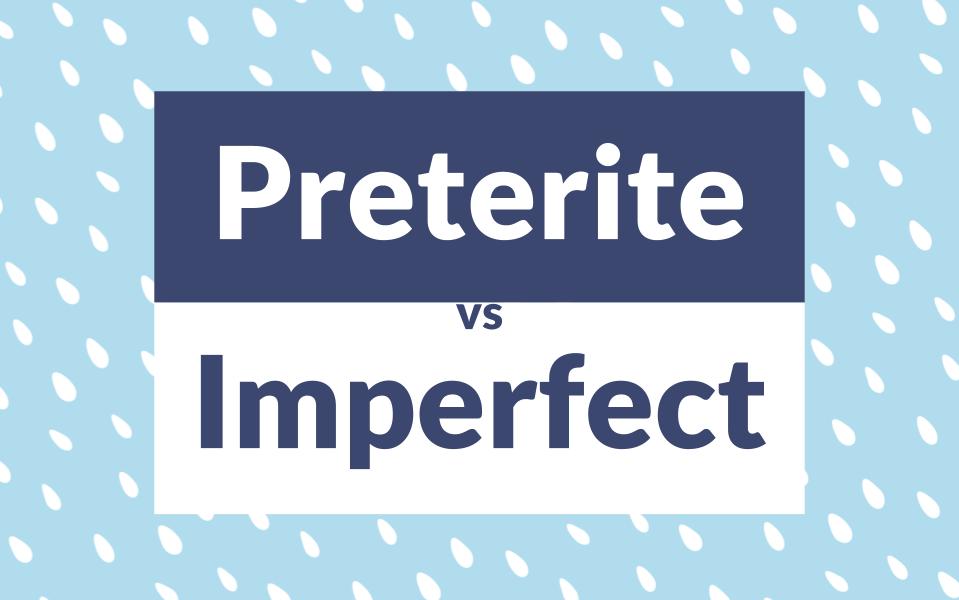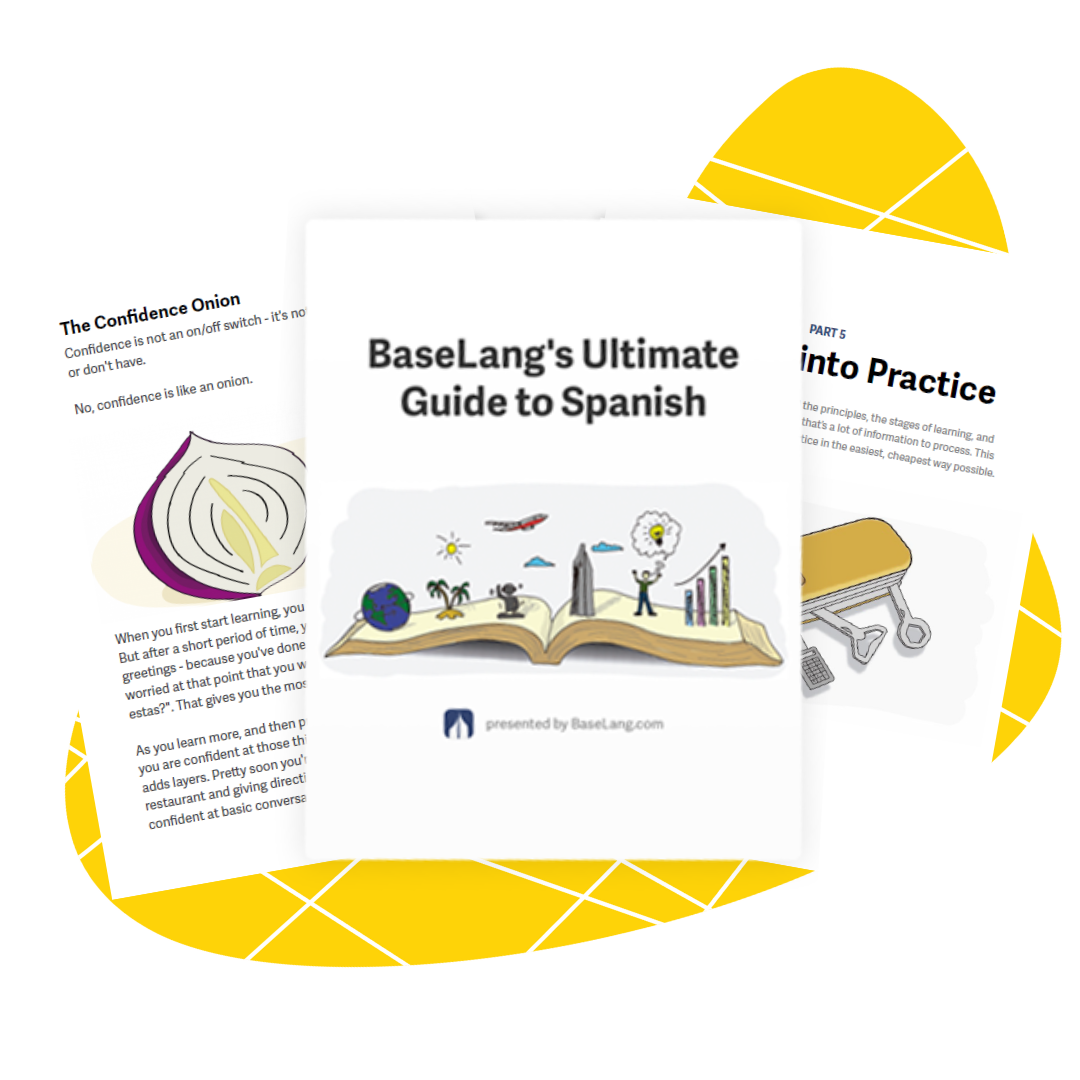Preterite vs Imperfect: An Anti-confusion Guide

Get our free email course, Shortcut to Conversational.
Have conversations faster, understand people when they speak fast, and other tested tips to learn faster.
More infoAs you may know, there are five unique past tenses in Spanish. While several are straightforward enough for learners, a couple of them are notorious for causing confusion among English speakers. If you’re among those looking for a clear explanation to differentiate between preterite vs imperfect, you’ve come to the right place.
This is a big post, so feel free to scroll down to the section you’re looking for. Here are the topics we’ll cover:
When to use the preterite tense
Preterite conjugation
When to use the imperfect tense
Imperfect conjugation
Comparisons: When to use preterite vs imperfect
Trigger words for preterite and imperfect
Verbs whose meaning changes between tenses
Preterite vs imperfect practice
As always, we’ll include loads of examples throughout our post to demonstrate our lesson. Now let’s dive in and learn all about when to use preterite vs imperfect!
The main difference between preterite and imperfect
To sum up this entire lesson into a couple of quick lines, here are the key points to remember on when to use preterite vs imperfect in Spanish:
- Preterite: When talking about completed actions in the past
- Imperfect: When talking about ongoing or habitual actions in the past
Of course there are more details than this, but it’s a good start. For a quick video lesson on the other key points to consider between Spanish preterite vs imperfect, take a look at what Mafalda has to say:
Now that we have the main big-picture difference between preterite and imperfect, let’s go deep into each one and then start comparing the two.
The Spanish preterite tense: El pretérito indefinido
The first past tense we’re introducing here is known as el pretérito indefinido in Spanish. Though it’s sometimes called the simple past in English, we generally call it by its direct English translation in order to keep it clear: the Spanish preterite tense.
The Spanish preterite tense is used to refer to past actions which were completed at a definite time, with clear beginning and end points. The verb in preterite refers to that stretch of time when it was happening as a single unit, whether the action happened in the blink of an eye or over a long period. The point is that it happened once, and it’s over.
Let’s see a few examples of such completed actions being described using the préterito indefinido:
- Tiré el ratón por la ventana. – I threw the mouse out the window.
- La perra comió su comida, luego lamió su cuenco. – The dog ate her food, then licked her bowl.
- Los dinosaurios existieron en la tierra durante millones de años. – Dinosaurs existed on earth for millions of years.
Since the focus of this post is a comparison of the difference between preterite and imperfect Spanish, we’ll leave our specific preterite explanation at that for now. We’ll take a closer look at the preterite tense when we get to the section on comparisons below, while if you want a deeper discussion on just the preterite, we’ll recommend our dedicated post on how to master the Spanish preterite in minutes.
Spanish preterite conjugation
Before we move on, we’ll introduce the preterite conjugations so you recognize them against the imperfect conjugations that we’ll see in the next section. Feel free to skip this conjugation section if you’re more interested in just understanding when to use preterite vs imperfect.
For the most part, preterite conjugation is fairly straightforward since the endings are all pretty similar between the different families of Spanish verbs. For regular verbs, we just drop the last two letters of the infinitive to get the stem, and then add the following endings for the -ar, -er, and -ir verbs:
| Subject | -ar verbs | -er verbs | -ir verbs |
| Yo | -e | -í | -í |
| Tú | -aste | -iste | -iste |
| Él, Ella, Usted | -ó | -ió | -ió |
| Nosotros, Nosotras | -amos | -imos | -imos |
| Ellos, Ellas, Ustedes | -aron | -ieron | -ieron |
Did you notice that the -er and -ir verbs have the exact same preterite conjugation?
And do the first-person plural conjugations look familiar? That’s because the preterite conjugation for nosotros / nosotras is identical to the simple present conjugation.
Now let’s see a few more examples with each family of regular verbs: -ar, -er, and -ir. Each verb’s infinitive and stem is noted in parentheses.
- ¿Terminaste tu trabajo? – Did you finish your work? (terminar: termin-)
- No comimos asado el domingo pasado. – We didn’t eat barbecue last Sunday. (comer: com-)
- Los chicos partieron temprano anoche. – The kids left early last night. (partir: part-)
But what about irregular verb preterite conjugation? Well, the good news is that many Spanish verbs that are irregular in other tenses still follow the same regular preterite conjugation rules we just saw. In other words, the preterite still often uses the same stem and the same endings as regular -ar, -er, and -ir verbs.
- El tren llegó 20 minutos tarde. – The train arrived 20 minutes late. (llegar: irregular -ar verb)
- No reconocí a Martín. – I didn’t recognize Martín. (reconocer: irregular -er verb;)
- ¿Donde dormiste anoche? – Where did you sleep last night? (dormir: irregular -ir verb)
Unfortunately, it’s not quite so straightforward, since many irregular Spanish verbs don’t follow these same rules in the preterite. When you study each irregular verb, it’s therefore important to take note of any changes in each of the tenses!
For many irregular verbs, the preterite has an entirely different root which just needs to be memorized. For this class of preterite conjugation, another set of endings is added to these irregular stems:
| Subject | Irregular preterite verbs |
| Yo | -e |
| Tú | -iste |
| Él, Ella, Usted | -o |
| Nosotros, Nosotras | -imos |
| Ellos, Ellas, Ustedes | -ieron |
Now that you know this set of preterite endings for irregular verbs, let’s see a handful of examples. For each of these verbs, we note in parentheses the infinitive form along with its preterite stem.
- ¿Estuvieron en la calle hasta tarde? – Were you on the street until late? (estar: estuv-)
- Mariana estuvo delante de mí, pero no supe qué decir. – Mariana was in front of me, but I didn’t know what to say. (estar: estuv-; saber: sup-)
- Se detuvieron a mirar el escaparate. – They stopped to look at the shop window. (detenerse: se detuv-)
- Anduvimos en bicicleta todo el día. – We rode our bikes all day long. (andar: anduv-)
- Pudimos preparar la cena a tiempo. – We were able to prepare dinner on time. (poder: pud-)
- Pusimos la mesa junto a la ventana. – We placed the table next to the window. (poner: pus-)
- No hiciste mucho por ayudarme. – You didn’t do much to help me. (hacer: hic-)
- No quisieron pagar la cuenta. – They didn’t want to pay the bill. (querer: quis-)
- Julia vino a verme en la noche. – Julia came to see me at night. (venir: vin-)
- Dije que no estaría en casa. – I said I would not be at home. (decir: dij-; estaría is in imperfect)
- Conduje una hora al aeropuerto. – I drove one hour to the airport. (conducir: conduj-)
- Pedro tradujo la letra de esa canción. – Pedro translated the lyrics of that song. (traducir: traduj-)
This was just a brief explanation on irregular verbs. If you want to go into a lot more depth, check out our full post on irregular preterite verbs.
The imperfect past tense in Spanish: El préterito imperfecto
In contrast to the preterite tense we’ve looked at so far, where the actions it refers to clearly began and ended, the Spanish imperfect tense is used to talk about actions that happened in a continuous state.
This can be for actions which took place regularly in the past on a habitual basis, for actions which were ongoing before being interrupted by another sudden action (usually expressed in preterite), or for other ongoing states like ages or timeframes. The imperfect tense is also used to express courtesy.
This tense is known as el préterito imperfecto in Spanish. Before we get into imperfect conjugation, let’s see a few examples of the Spanish préterito imperfecto in use:
- Cuando era niño caminaba por la playa a diario. – When I was a kid I used to walk on the beach every day.
- Mirábamos televisión cuando alguien golpó la puerta. – We were watching television when someone knocked at the door. (golpó is in preterite)
- Era una noche fría y tormentosa en el pueblo de Miramar. – It was a cold and stormy night in Miramar town.
- Mi familia se mudó a Texas cuando yo tenía cinco años. – My family moved to Texas when I was five years old. (se mudó is in preterite)
- ¿Me pasarías la sal, por favor? – Could you pass me the salt, please? (this use is simply to express courtesy)
We’ll go into a lot more detail in our comparison of imperfect vs preterite below. If you want more detail on this specific tense, check out our easy guide to the Spanish imperfect tense.
Spanish imperfect conjugations
Fortunately for Spanish learners, imperfect conjugation is simpler than for the preterite. That’s because in Spanish imperfect there are only three irregular verbs! Aside from those three, which we’ll see next, here are the imperfect endings for the rest of the Spanish verbs:
| Subject | -ar verbs | -er verbs | -ir verbs |
| Yo | -aba | -ía | -ía |
| Tú | -abas | -ías | -ías |
| Él, Ella, Usted | -aba | -ía | -ía |
| Nosotros, Nosotras | -ábamos | -íamos | -íamos |
| Ellos, Ellas, Ustedes | -aron | -ían | -ían |
Just as we saw with the preterite, did you notice that the imperfect endings are identical for -er and -ir verbs? The first- and third-person singular conjugations are also identical. Easy!
The only three irregular imperfect verbs you need to learn specifically are ir – to go, ser – to be, and ver – to see. Here’s the imperfect conjugation table for those three:
| Subject | Ir | Ser | Ver |
| Yo | iba | era | veía |
| Tú | ibas | eras | veías |
| Él, Ella, Usted | iba | era | veía |
| Nosotros, Nosotras | íbamos | éramos | veíamos |
| Ellos, Ellas, Ustedes | iban | eran | veían |
These three Spanish verbs are so important in the language that we can recommend specific posts touching on each one. For an easy way to talk about the future using ir, check out our post on the voy a hack. For a detailed explanation of the two options for to be in Spanish, check out our post on ser vs estar. For a comparison of to see and to look in Spanish, check out our post on ver vs mirar.
Comparisons: When to use preterite vs imperfect
The key idea to keep in mind when using the preterite vs the imperfect tense in Spanish is that we use the preterite to talk about what we did, and the imperfect to refer to what we were doing or what we used to do in the past.
Whereas the preterite is often translated into English with some variation of did happen, the imperfect is frequently translated with some variant of was happening or used to happen. Again, this underlines the main difference between the two for referring to completed actions vs ongoing actions.
Translating the English simple past happened into Spanish isn’t as straightforward: we still need to clarify the timeframe using preterite or imperfect.
In this section, we’ll present different situations which require either the preterite or the imperfect. Let’s see these contrasting uses with a bunch of preterite vs imperfect examples:
In these first examples, the preterite refers to a momentary action, while the imperfect refers to repeated or sustained actions:
- Preterite: La Segunda Guerra Mundial comenzó el 22 de junio de 1939. – War World II started on the 22nd of June, 1939.
- Imperfect: En esas tierras siempre había guerras. – In those lands, there were always wars.
- Preterite: En ese momento, sentí miedo. – At that moment, I was scared.
- Imperfect: Cada vez que iba a la montaña rusa sentía miedo. – Every time I went to the rollercoaster I was scared.
- Preterite: Compramos nuestro apartamento actual hace tres años. – We bought our current apartment three years ago.
- Imperfect: Nuestro primer apartamento era pequeño y solo tenía un dormitorio. – Our first apartment was small and had only one bedroom.
- Preterite: Sospeché de él enseguida. – I suspected him right away.
- Imperfect: Él me mentía durante meses. – He was lying to me for months.
- Preterite: Todo terminó cuando me dijo la verdad. – It all ended when he told me the truth.
- Imperfect: Eran tiempos difíciles para nosotros. – Those were hard times for us.
- Preterite: Ayer con mi profesor de BaseLang, ¡hablamos español durante una hora! – Yesterday with my BaseLang teacher, we spoke Spanish for an hour!
- Imperfect: En el viaje con mi novia hablábamos español todos los días con dificultad. – On the trip with my girlfriend, we spoke Spanish every day with difficulty.
In these next examples we mention multiple actions that happened in the past. Successive finite actions are described with the preterite, while simultaneous continuous actions take the imperfect:
- Preterite: Cuando regresé de Argentina, empecé a aprender español en serio. – After I returned from Argentina I started to learn Spanish seriously.
- Imperfect: Estudiaba español con una aplicación mientras viajaba por Argentina. – I was studying Spanish with an app while I was traveling in Argentina.
- Preterite: Fuimos a la tienda, compramos la comida y llegamos a casa. – We went to the store, we bought the food, and we arrived home.
- Imperfect: Mientras nosotros escribíamos, ellas leían y el perro dormía. – While we were writing, they were reading and the dog was sleeping.
- Preterite: El domingo por la mañana anduve en bicicleta y mi hermano corrió. – On Sunday morning I rode my bike and my brother ran.
- Imperfect: Yo andaba en bicicleta y él corría cuando los aviones de combate volaron (preterite) encima. – I was riding a bike and he was running when the fighter jets flew overhead.
That last example shows how we can use the imperfect to set the scene for what was happening when some sudden action then happened in the preterite. These next preterite vs imperfect examples all include both tenses in the same sentences:
- Comíamos (imperfect) el postre cuando ellos llegaron (preterite). – We were eating dessert when they arrived.
- Cuando íbamos a salir (imperfect) alguien golpeó (preterite) la puerta. – When we were about to leave someone knocked at the door.
- Mirábamos (imperfect) por la ventana cuando nuestros abuelos se fueron (preterite). – We were looking through the window when our grandparents left.
- El perro corría (imperfect) a su lado cuando Juan se cayó (preterite) de la bicicleta. – The dog was running beside him when Juan fell off the bike.
- El clima estaba (imperfect) muy lindo hasta que llegaron (preterite) las nubes. – The weather was nice until some clouds arrived.
- La niña tenía (imperfect) solo 4 años y no supo (preterite) cómo cruzar la calle. – The girl was just 4 years old and didn’t know how to cross the street.
- Eran (imperfect) las 10 de la noche cuando mi papá llegó a casa (preterite). – It was 10pm when my dad got home.
- Tenía (imperfect) 15 años cuando fue (preterite) a París. – She was 15 when she went to Paris.
In these last few examples, note that we used the imperfect to refer to a time of day in the past, and to refer to when someone was a certain age. See our detailed post for more on how to tell time in Spanish.
In these final examples, we show a unique use for imperfect Spanish, which is to show courtesy in requests and inquiries:
- Imperfect: ¿Qué deseaba? – What would you like?
- Imperfect: Perdone, quería hablar con el gerente. – Excuse me, I’d like to talk to the manager.
Preterite vs imperfect examples: Summary
Through all the examples in this section, the common thread is that the preterite is used to describe actions at a specific time in the past, while the imperfect is used on habitual or ongoing actions.
We also saw how both tenses can be used in the same sentences, with the imperfect setting the stage and the preterite stating the action that interrupted it.
Finally, we saw how the imperfect is also sometimes used simply to show courtesy.
Trigger words for preterite and imperfect
So far we’ve seen that the preterite tense is used to talk about completed actions, while the imperfect tense is used to talk about actions that were ongoing. But what other clues in the sentence can tell us which tense to use?
In this section we’ll introduce lists of Spanish timeframe words that are either used to talk about a specific completed moment in the past (preterite), or that are used to talk about recurring times in the past (imperfect).
Preterite trigger words
The trigger words for preterite refer to specific timeframes in the past that happened once and ended. If a story is introduced with one of these words, it’s pretty certain that we need to use the preterite past tense.
| Una vez | Once |
| Desde el primer momento | From the first moment |
| En aquel momento | At that moment |
| De repente | All of a sudden |
| Entonces | Then |
| Ayer | Yesterday |
| Anteayer | The day before yesterday |
| Anoche | Last night |
| Anteanoche | The night before last night |
| El otro día | The other day |
| [Period of time] pasado/a | Last [period of time] |
| Hace [period of time] | [Period of time] ago |
| Durante [period of time] | For [period of time], During [period of time] |
Let’s see a few examples of these preterite trigger words talking about specific instances in the past. Remember that the completed action might have lasted just a moment, while it could also have lasted for years!
- En aquel momento me di cuenta (preterite) de que algo estaba mal. – At that moment I realized that something was wrong.
- Hace 8 años trabajé (preterite) en esta estación de servicio. – I worked in this gas station 8 years ago.
- Tomamos (preterite) clases de guitarra durante cuatro años. – We took guitar lessons for four years.
For an in-depth explanation of ago in Spanish, check out post on using hacer to express time.
Imperfect trigger words
Now take a look at this list of trigger words for imperfect. They all suggest an extended timeframe, whether describing that the action happened habitually in the past, or that it was ongoing during the timeframe we’re referring to.
| Siempre | Always |
| Todo el tiempo | All the time |
| Con frecuencia, Frecuentemente | Frequently |
| A menudo | Often |
| Muchas veces | Many times |
| Algunas veces | At times |
| A veces | Sometimes |
| Casi nunca | Almost never |
| En aquella época | In those times |
| Todos [period of time] | Every [period of time] |
| Cada [period of time] | Every [period of time] |
| Mientras | While |
Let’s see some examples with a few of these words that trigger the imperfect tense:
- Bob Marley fumaba (imperfect) todo el tiempo. – Bob Marley smoked all the time.
- En aquella época, nos quedábamos (imperfect) en la playa hasta la medianoche. – In those times, we would stay at the beach until midnight.
- Mientras ustedes comían (imperfect), nosotros cocinábamos (imperfect). – While you were eating, we were cooking.
Comparison: Preterite vs imperfect trigger words
Now that we’ve seen both sets of trigger words, let’s see a few sentences where the contexts are similar, but where there’s a clear difference between preterite and imperfect:
- Anoche fuimos (preterite) al teatro. – Last night we went to the theater.
- A menudo íbamos (imperfect) al teatro. – We went to the theater often.
- El otro día vimos (preterite) a tu hermano. – The other day we saw your brother.
- Cada domingo veíamos (imperfect) a tu hermano. – We used to see your brother every Sunday.
- Una vez fuimos (preterite) de vacaciones a las montañas. – Once we went on vacation to the mountains.
- Siempre íbamos (imperfect) de vacaciones a las montañas. – We would always go on vacation to the mountains.
Verbs whose meaning changes between preterite and imperfect
In a few cases, the nuance of a verb’s meaning changes depending on whether it’s used in the preterite or the imperfect tense. To introduce this concept we’ll cover the most important verbs where it happens: saber, conocer, querer, and poder.
Conocer: preterite vs imperfect meanings
Conocer generally means to know, to get to know, or to be familiar with. In the simple past it’s more along the lines of got to know, or perhaps became acquainted with or even just met. In the imperfect, on the other hand, it’s more along the lines of being familiar with:
- Preterite: Ayer conocí a su novio – Yesterday I met her boyfriend.
- Imperfect: Conocía a su novio de la televisión. – I knew her boyfriend from the television.
Saber: preterite vs imperfect meanings
Saber also translates as to know in Spanish, but more along the lines of knowledge. While saber in imperfect indeed means knew, in preterite it has the nuance of finding out or learning of:
- Preterite: Ya supieron de la reunión. – They found out about the meeting.
- Imperfect: Ya sabían de la reunión. – They already knew about the meeting.
For a full discussion conocer vs saber, see our detailed post on to know in Spanish.
Querer: preterite vs imperfect meanings
Querer is a verb with many nuances in Spanish, often simply translated as to want. While this can be a good translation in the imperfect, in the simple past quise can also imply a failed attempt:
- Preterite: Quise buscar el tesoro. – I tried to find the treasure.
- Imperfect: Quería encontrar el tesoro. – I wanted to find the treasure.
Poder: preterite vs imperfect meanings
Poder has several meanings, but its primary translation is simply to be able to.
- Preterite: No pude escribir porque no tenía papel. – I failed to write because I didn’t have any paper.
- Imperfect: No podía escribir nada, mi mente estaba en blanco. – I wasn’t able to write anything because my mind was blank.
For a deeper look at this verb, see our related post on poder conjugation.
Conclusion
In this anti-confusion guide to the Spanish preterite vs imperfect tenses, we’ve covered everything you need to know so you’ll always use the right one.
We started off with the basics of each of these Spanish past tenses, including their unique conjugations. Then we got into our big comparison of the two tenses, namely through a big set of example sentences demonstrating their key differences.
Building on the notion of timeframes that relate to one tense or the other, we went through lists of introductory words that trigger the preterite or the imperfect.
Finally, we saw how certain verbs’ meanings can change when used in one tense or another.
Remember, we also have specific posts on most of the Spanish tenses. Check out our big post on all the Spanish verb tenses for an overview and links to the others, or refer to the specific posts on the Spanish preterite tense and the Spanish imperfect tense for more on the two we’ve compared here. You may also be interested in learning some of the other common mistakes Spanish learners make: confusing the imperfect and preterite is on this list!
For now though, we hope this anti-confusion post has helped you get a solid grasp on when to use preterite vs imperfect in Spanish!
Preterite vs imperfect practice
We’ll leave you with a little preterite vs imperfect quiz where you can practice what you’ve learned. The preterite and imperfect conjugations of each verb are provided. Based on the context, just choose the correct tense for each sentence. The answers and translations are below.
1. La niña (tuvo – tenía) los ojos azules.
2. De repente, Pedro (golpeó – golpeaba) la puerta.
3. Casi nunca (fuimos – íbamos) al médico.
4. Hace un mes (ganamos – ganábamos) la Copa del Mundo.
5. En aquellos tiempos, solo (comimos – comíamos) vegetales.
6. Matías y Andrea no (quisieron – querían) ir a bailar anoche.
7. Estábamos mirando la televisión cuando (escuchamos – escuchábamos) ruidos.
Quiz answers
1. Imperfect: La niña tenía los ojos azules. – The girl had blue eyes.
2. Preterite: De repente, Pedro golpeó la puerta. – All of a sudden, Pedro knocked at the door.
3. Imperfect: Casi nunca íbamos al médico. – We never used to go to the doctor.
4. Preterite: Hace un mes ganamos la Copa del Mundo. – A month ago, we won the World Cup.
5. Imperfect: En aquellos tiempos, solo comíamos vegetales. – In those times, we would only eat vegetables.
6. Preterite: Matías y Andrea no quisieron ir a bailar anoche. – Matías and Andrea didn’t want to go dancing last night.
7. Preterite: Estábamos mirando la televisión cuando escuchamos ruidos. – We were watching television when we heard a noise.





